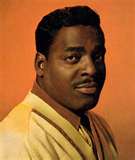The era of the Big Bands had ended by 1949. This gave way to the rise of the solo vocalist.
In 1951, one such vocalist arrived in the form of Johnnie Ray. Despite having a series of hits in a recording career that lasted for almost a decade, the late, great Johnnie Ray is almost forgotten today.
Mainstream popular music in the early 1950s was staid, reflective of the mores within American culture at that time. So when Johnnie Ray appeared and began delivering performances which featured such a unique style, the teenagers went wild.
Johnnie became the first white artist to remove the microphone from its stand. His presence on stage was both raw and unpredictable. He would remove his shoes, roll on the floor, pound his fist on the piano, and literally cry. Such behaviour, in some quarters, earned him the nickname of the ‘Nawab of Sob’.
Years before James Brown took to collapsing on stage, Johnnie had perfected the art. An attendant would enter from a wing to ‘revive’ him by offering a glass of water. Little did the audience realise, the glass contained not water but vodka.
http://youtu.be/tIhIa72cUXY
Partially deaf as the result of a childhood accident, John Alvin Ray had been born into a deeply religious farming family, in Oregon, in January of 1927. His initial release, “Cry”, in 1951, was such a meteoric and momentous success that no one outside of his record company, Okeh, knew anything about him. Not only did “Cry”, which became his trademark song, spend eleven weeks atop the American hit parade but the record’s B-side, “The Little White Cloud That Cried”, which he had penned himself, occupied the No.2 position, simultaneously. Something that had never been achieved before.
In 1954, Johnnie appeared in the film, ‘There’s No Business Like Show Business’, cast as one of Dan Dailey and Ethel Merman’s children. The film also starred Marilyn Monroe, Donald O’Connor and Mitzi Gaynor.
When Johnnie Ray visited Australia for a second time, in 1955, ten thousand fans greeted him at the airport. In fact, he was to tour that country on something like nineteen occasions and with the advent of rock and roll it was to be countries such as the United Kingdom and Australia that continued to support the sale of his records during the latter part of his career.
http://youtu.be/XvB3KbERNP4
Although not all of Johnnie’s recordings suited his style — for example, I much prefer The Drifters performing “Such A Night” to Johnnie’s cover, despite his version having reached No.1 on the British charts, in 1954 — those that did, I regard as classics of his era. “Cry”, speaks for itself as do his revivals of the numbers “Walkin’ My Baby Back Home”, “Here Am I – Broken Hearted” (both from 1952) and “Just Walking In The Rain” (1956). Whilst I am an atheist, as a person enamoured of music I must admit that I truly enjoy listening to his religious releases, such as “Satisfied” (1952) and “If You Believe” (1955); as well as the hits “Yes Tonight, Josephine” and “Look Homeward, Angel” (both from 1957) and perhaps my favourite track of Johnnie Ray’s: “I’ll Never Fall In Love Again”, which he wrote and first recorded in 1952 before a much more polished version was released in 1959. While it did little business in America and Great Britain, it reached its zenith at No.1 in Australia.
http://youtu.be/8FGEVLeaDU4
Following the monumental success of his first release, Johnnie Ray was hastily signed to record on the Columbia label. It was there that he also recorded in duet with Doris Day. The most successful of these was the ditty, “Let’s Walk Thata-Way”, in 1953.
Johnnie last appeared on Australian charts in the early months of 1960, when he took “When It’s Springtime In The Rockies” to as high as No.13. His liver finally failed him, in February of 1990, at the age of sixty-three.
For the names of more tracks recorded by Johnnie Ray please consult the suggested playlists, where you shall also find a list of more of my favourite recordings. I shall be adding to this list from time to time.

